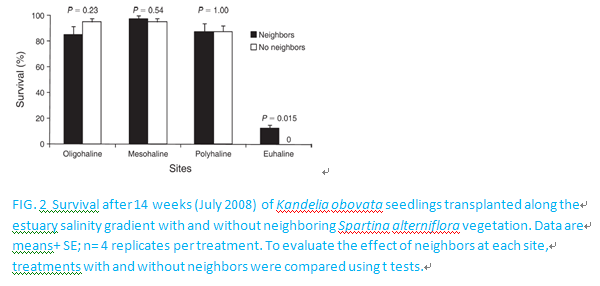Zhang YH, GM Huang, WQ Wang, LZ Chen and GH Lin.Ecology, 2012. 93: 588-597.
Cordgrass (Spartina alterniflora) was introduced to China in 1979 from the United States for reducing coastal erosion. It grows vigorously in China and has spread over much of the Chinese coast, from Leizhou Peninsula to Liaoning, a range of more than 19 degrees of latitude. On the southern coast of China,S. alterniflorahas invaded mangrovedominated habitats during the last two decades, but little is known about interactions between native mangroves and invasiveS. alterniflora.
We studied the distribution and competitive interactions between native mangroves andS. alterniflorain the Zhangjiang Estuary at four tidal sites along a salinity gradient: oligohaline upstream, mesohaline, polyhaline, and euhaline downstream.S. alternifloraoccurred at all four sites, and several mangrove species occurred at all but the downstream euhaline site.S. alterniflorahas invaded the estuary widely and has spread to the lower tidal margins of mangroves. It has not invaded mangrove areas with a closed canopy but has established in the
mangrove zone where the canopy was opened by human disturbance.
Ramets ofS. alternifloratransplanted into the understory of mangrove stands with closed canopies died within 10 weeks, but 37.5% survived and grew well on open mud flats.S. alterniflorahad virtually no competitive effect on mangrove seedlings planted at the upstream oligohaline site. However,S. alternifloracompetitively reduced biomass of mangrove seedlings to 33% over a period of 14 weeks at the mesohaline and polyhaline sites where human disturbance has opened the mangrove canopy. In contrast,S. alternifloramarginally facilitated
growth and survival of experimental seedlings at the downstream euhaline site.
In China, mangroves occur along the coastline south of Whenzhou, but they have been severely disturbed and removed widely, mainly by mariculture activities. Natural vegetation patterns and our experimental results suggest that, without intervention,S. alternifloracould gradually replace these mangroves in mid-salinity regions of Chinese estuaries.


